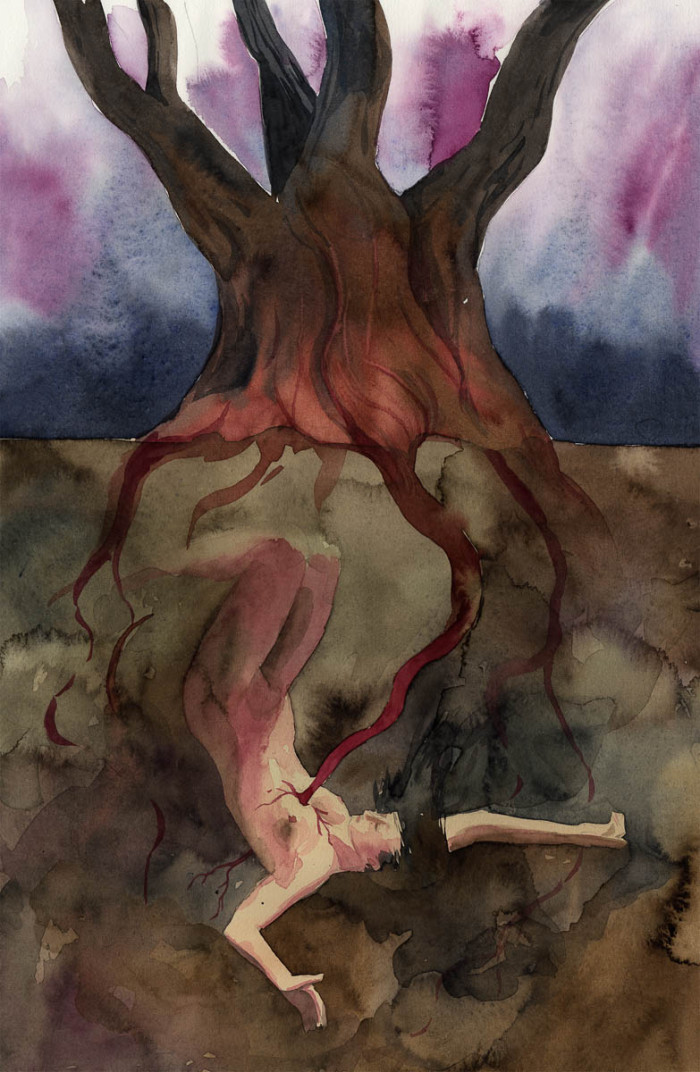Original post: http://www.electro-gn.com/303-jeuetnarration-deuxiemepartie
Translation: Vincent Choupaut
In the first part of this article, we saw the opposition between game and narration in video games, and we will study now the consequences for larps.
LARP: Game or narrative medium
In the world of video games, we often make a difference between two kinds of games, according to the main interaction:
– Games with dominant rules: The player interacts with the rules above all
– Games with dominant story: The player interacts with a story above all
We can use this distinction apart from the world of video games. Chess game is a strong example of a game with dominant rules.
As for it, LARP is a game with dominant story. In most of larps, rules intervene only to manage problematic situations.
We can also lean on the ESAR system1, used in the game libraries: Role-playing games (tabletop and larps) are classified in the symbolic games. However, it seems fairer to say that larp finds its place between Rule Games and Symbolic Games, and integrates in its own way logics that are characteristic of these two kinds of games.
Every game doesn’t tell a story (except if you use this term in a very wide sense). It’s fairer to say that some games tell stories, and among these games, some have a stronger link to the story than others. And concerning our hobby, larp, this link is really strong. Larp finds its substance in stories. It can’t go without it to work! The entire things that we do in a larp would have meaning at all if they wouldn’t be part of stories. Tell the story is the purpose of the activity, at the same time as its means (as in the symbolic game of children: story is telling at every moment, to produce, in fine, a global story).
There is a very simple way to realize it: When organizers meet together to prepare a new game, they speak about scenario, plots… not playability!
The headache of stories to be played: The case of LARP
On this point, I think we can all agree. Larp is a game predominantly narrative. As an interactive fiction, how a larp allows us to play stories?
I’m going to point out some characteristics of larp, as we usually play it. I’m going to show how these characteristics take us away from quality, coherence, impact of a traditional narrative structure (tale, movie, novel, play…). We will also see that some characteristics are essential, whereas some others are more a matter of habit than necessity… and all in all, a bad habit.
And we can do without conventions… if we want it of course! I assume completely to suffer from Hollywood complex: My starting point is the linear story. My reference is the narrative theory.
Here are the characteristics which I suggest to examine in detail:
– Uncertainty
– Multi-players
– Action / Time / Space
Uncertainty
The uncertainty is a burden upon all the game activities: in chess game, where the outcome in unknown, even a few turns before the end; in symbolic game of children, in which story is built according to a generative logic. It is a very intuitive criterion, easily recognized, which allows, with not much doubt, to say if an activity is a game or not. It is what makes the interest of the game compared with all other activities in which course and outcome are set: theatre, ceremony, etc. Game is precisely a device in which there is game. In larp, the uncertainty comes from two sources:
1/ Uncertainty of players who don’t know what the organizers planned. No one can really say how the scenario will look like, even if you can have some expectations and plausible assumptions. Reciprocally, the organizers don’t know in advance the way the players will react to the game they planned.
Contrary to improvisational theatre, where actors don’t need a third party to liven up, larp, as tabletop rpg, works with the principle of the intervention of a third party, who sets up the elements of the game, its departure device, and so on. In larp, everything happens as if the director came to rehearse on Monday without the actors, and that the actors came on Tuesday to rehearse without the director.
2/ Uncertainty of the players, ones to the others. As in improvisational theatre, I can’t be sure of what the others will produce (even if there are rules, expectations, conventions, codes). Many games set up events which will take place whatever the players will do, including sometimes the end of the game… Question. Are we still in a game in that case?
Multi-Players
The LARP is, out of necessity more than by nature, organized for several players. I say out of necessity, because fundamentally, larp for one player is totally conceivable (there besides a few ones).
But considering the effort to organize a larp, we want that as much as possible people take the most of it. And we have so much the habit to design multi-players games that it would be difficult to design a solo larp.
So there are traditionally several players in a larp. Several players, so several points of view. Several players, so no hero or only heroes (which is the same thing: if there are only heroes, there is no one). It goes away from the canons of the story, where there is just one protagonist, and secondary characters.
A larp for one player would be probably the closest to the requirements of a story trying to obey to the traditional rules of narrative. Everything would have sense considering the only active character. The NPCs would stir around him like the secondary characters of a novel. The point of view of the player is the only which matters, as his actions.
Action
The truncated action:
Plots start into the character sheet… and often, the most interesting part of plots is already behind the character when he starts the larp. It goes away from the story in which there is first a basic situation and a character. It’s just later that the situation will change, and that the character will try to accomplish some objectives, overcoming the obstacles on his way. So in a larp, story and plots are set up before the game, instead of appearing during the game.
In a video game, a quest is defined by a succession of phases: Discovery of the objective / Discovery of an obstacle to accomplish the objective / Search for a solution / Application of a solution and accomplishment of the objective. In a larp, only a few of these phases happen, often the last ones.
The shared action:
Larp being traditionally designed for several players, everybody must have game. Two kinds of games emerge.
1/ Games centered on a main plot
They are close to the traditional story, which structures the different actions of the character around a central action. Problem is that larp is generally multi-players, and it is difficult to connect all players around a main story. It falls easily into the failings of the “end of the world”, or “return of the lord of darkness” main plot. They are abstract threats, which don’t really concern the players. And so they prefer to focus on their secondary plots. But most of the time, the main plot concerns only a small group of players, who are the only ones who can involve into solving the problem (ex.: “We know that the bad guy is coming back, and we know how to defeat him”). The other players are often spectators, at best curious, and in the worst case completely helpless and frustrated. That’s why some desperate players, who glide over the story, tend to graft onto these locomotives.
2/ Games without center of gravity:
In that case, the game uses a pretext to the meeting instead of a main plot, to justify the presence of the characters. The players share above all an atmosphere, but the action has no pivot: it’s multi-centered. The game is organized with networks or poles, some events drive the game and mark some moments, but they are independent from each other and don’t form the elements of a story. Of course these games go away from a traditional story, and their strength (no artificial main plot) is also their weakness (these games don’t benefit from the structural and dynamic effect of a main plot).
Time
In a larp, time of the game is time of the story. Some events remind the players that the main action evolves. Rest of the time, it’s free game which prevails, when each player can play with his own personal plots. These plots may not be solved, or solved after five minutes, or after two days. But a plot should have an appropriate and privileged moment to be solved. The involved players might find this moment, and in that case they will keep a nice memory of it. The problem is that this moment could never come, or come in an inappropriate moment.
So the action doesn’t necessarily become more intensified and complex, as in a story. Things happen in the wrong order, whatever dramatic importance they could have.
Besides, the rare events planned by organizers might sometimes not tally with the current state of the game, the mood of the players… anyway, with the reality of free game at a given moment. It is the meeting between free game and programmed event.
Moreover, this is a continuous time: people have to play continuously. The only expected break is often the night. Rest of the time, the player who feels shattered remains in game, but his performance feels the effects. He may also stand apart, but it deprives the other players of his presence. Play continuously is attempting the impossible.
Space
Space is often in conflict with time or action during a larp. Players roam sometimes big spaces. Of course, some places are sometimes reserved to a category of characters. However, the remaining space is a sort of public space. Players have to share this space and determine where the action happens. It forces the organizers to favor one of these two logics, which have both drawbacks:
1/ You can work on the assumption that if the player is not at the right place at the right time, it’s a pity for him. Some events take place whatever could happen. If some people had to be there to solve some plots, it’s a pity for them. I attended games in which some events took place without any player to see them.
2/ You can work on the assumption that all the players must attend the scene, because it is impressive and the organizers spent a hard time to design it, or because it is important to understand the development of the scenario. And it becomes a show, with 50 other players to attend it. On the contrary, you can also ban a place, because a scene that some players shouldn’t see is going to happen (organizers sometimes said to me to move around 500 meters farer and to keep my ears shut to avoid attending a scene…).
Theoretically, being constrained doesn’t shock me. What disturbs me is when a free game is interrupted with some obligations or prohibitions.
Let’s talk finally about the “curious onlooker phenomenon”: in an open and public space, temptation is strong for a player to come up to everything that looks like an event, closely or remotely. So it is frequent to see a crowd of onlookers as soon as something happens and break the routine of the game. It is the curiosity of the player which overrides the matters of roleplay, respect for the objectives, and so on.
Conclusion
To conclude on space and time in larp, we can say that they are pretty much unstructured. But space and time are the first things to control when you want to tell a story (unit of time, unity of place, united action). So we can say that stories in larp rest on fragile bases, and that any organizer who fantasizes on his scenario risks to be disappointed by the turn of events during the game. Multiply this risk by the number of players, and it provokes to me regularly the feeling to be playing at a MMORPG… It’s maybe not the kind of adventure I want to live in a larp.
In these conditions, the players search for the game, but don’t always find it. Once the game started, the players do more or less what they want, when they want, where they want and how they want. Another way to see this it to say that in these conditions, players do what they can, when they can, where they can and how they can…
The combined effect of these conventions on action, time and space often undermined experiences of game:
– I solve a plot too quickly. As the other ones, it started in my character sheet, but circumstances make that it doesn’t resist more than five minutes during the game. It’s not really annoying if it is a minor plot. But it is sometimes a major plot, and it becomes a problem.
– On the opposite, I solve a plot too slowly. The conditions are not combined to allow me to solve it in an appropriate moment of the game.
– I am surrounded with people who cause interferences to my game and undermine the intensity of my scenes. We all played sentimental scenes, whereas players on our right hand are fighting, and players on our left hand are out of the game and talking about a football match. Of course, it applies to the intensity of any scene, not only the sentimental ones.
– One of my plots doesn’t fit during the game, because I don’t meet the right people, or because these people don’t get involved.
– The people with whom I have to play are nowhere, or constantly unavailable, or exhausted, or completely out of their roles.
– A player comes into my group… because he gets bored.
– etc.
My observations of the characteristics of a larp show me that there are elements which harm the story I try to tell. Is it inescapable? Which characteristics are necessary, and which ones are just conventions? It is to these questions I will try to answer in the next part of this article.
1. ESAR is a classification system for games (Exercise, Symbolic, Assembling, Rules), used in several countries : http://www.systeme-esar.org/index.php?id=25287






